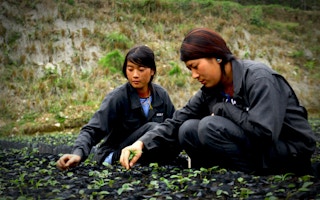In the rugged Himalayan mountains of Bhutan, farmers are busy cracking the next big opportunity – hazelnuts.
Hazelnuts are endemic in Bhutan, but they have never been grown in a commercial and sustainable scale. Now, tens of thousands of local farmers are planting 10 million hazelnut trees on formerly degraded lands, fallows and mountain slopes.
This is the result of efforts by the Mountain Hazelnuts Group, a business where profits go hand-in-hand with positive effects on livelihoods and ecosystems preservation.
Summarising the group’s operations, the company’s founder and chief executive Daniel Spitzer, who is American, said: “We provide trees at no charge, people sell their harvested nuts back to us. We guarantee a floor price and participation in the market as the price goes up.”
To ensure that the hazelnuts are grown in ideal, environmentally friendly conditions, the company employs a special group of about 170 field monitors including female employees who zip around the orchards on motorcycles.
Field monitors help find suitable orchard lands for interested farmers, as well as inspect every tree every 30 to 45 days especially in the early years of cultivation, and are assigned up to 80 orchards each. They do this for the next three to five years until a hazelnut tree starts to bear fruit.
From the financial perspective, a climate-resilient and socially inclusive hazelnuts supply chain may not be an attractive proposition to investors who want quick returns on their money. This business model, said Spitzer, requires “investors who are willing to do a long-term bet”.
“We need to play with our hearts at some level. I’m having fun doing it,” he said.
Spitzer was speaking at a plenary at the inaugural Asian Development Bank’s Green Business Forum for Asia and the Pacific held in Manila late in November. The event brought together businesses, sustainability experts and governments to explore sustainable business prospects in the region.
Another important topic under discussion was the challenges eco-friendly businesses face in getting funding.
“
The capital is there. The intent is there. We got a long way to go, and I think we can get there.
Paul Tregidgo, vice chairman, global markets solutions group, Credit Suisse
Because these businesses tend to have slow returns, few private investors and private banks are interested.
Not all of them are as patient as the Asian Development Bank (ADB), for example, which invested $3 million in equity and $1.5 million in technical assistance as part of a $13.5 million deal for Mountain Hazelnuts Group’s expansion, while being willing to wait many years to make a profit.
Paul Tregidgo, who wears several hats in Credit Suisse, among them the vice-chairman of global markets solutions, said the main challenge lies in valuing natural capital, which refers to all natural resources into which businesses can tap for profit.
Governments and private banking sectors find it hard to put a price tag on nature for many reasons. One of them is identifying who owns that piece of land, for example, and therefore who should command its price.
Tergidgo said that although the difficulties are real, “we have to find a way”.
“There might not be a right way. The wrong way is not to do anything about it whatsoever.”
Every year, approximately $52 billion flows to the broadly defined natural capital space, he said. About 10 per cent comes from philanthropy.
But to preserve healthy ecosystems, natural capital businesses need about $300 to $400 billion dollars a year of investments, he adds.
How to increase capital flow into this sector?
He suggests three ways. First, there has to be a comprehensive data on the proposed business and its model. Second, there needs to be a proposal on innovative financial products that may support that business. Finally, the company needs to prove that the business is scalable.
Last year, Credit Suisse, working together with The Nature Conservancy and USAID as well as other NGOs, applied all three princples to lure investors to put money into certified products made from responsible forest use in Peru.
“The capital is there. The intent is there. We got a long way to go, and I think we can get there,” he concluded.
Rethinking risks and opportunities
To invest profitably and in environmentally-friendly ways, we also need to do away with the old accounting system and rethink the true cost of risks in natural capital. This is because businesses are highly exposed to environmental risks which are most of the time not calculated.
This was the argument made by Chaoni Huang, head of business development of Trucost Asia, which advises firms on how to quantify the environmental impact from their actions.
“The economic consequences of natural capital or environmental damage by businesses globally in the primary sector totals $7.3 trillion. That is 13 per cent of 2009 global GDP or equivalent to the size of China’s GDP at that time,” she said.
In fact, a recent study Trucost conducted for the UN Food and Agriculture Organisation revealed that the true cost of farm and livestock production is over 170 per cent of the production value.
As the population is set to reach 9 billion by 2050, Huang said food production and agriculture are sectors that now face the challenge of rising cost, climate change and environmental degradation.
“Clearly the accounting system that we are used to is not reflecting the environmental externalities that businesses are facing,” she said. “The free ride is not going to last forever. We are feeling it through rising commodity prices. We are feeling it through extreme weather events, water scarcity and a number of environmental challenges.”

















